




Interview by Mitch Gerson
July, 2005
Introduction
Ahhh…the Atari 2600. The "big one"…the place where it all began. Who doesn’t remember the Christmas of 1977 when, no matter how hard you tried, getting a 2600 was next to impossible. My brother, father and I must have visited every Toy 'R Us in the tri-state area that Christmas to no avail.
When we finally were able to get one in the winter of 1978, I vividly remember playing “Adventure” for over 8 hours. I think I went blind for about a week after, but the ability to enjoy those amazing graphics (!); and fun of that system was just too alluring at the time to stop playing.
Well, apparently Benjamin Heckendorn, a graphic artist and independent filmmaker, felt just as strongly about his Atari gaming Zen and has resurrected the original (yes, folks, the original boards/hardware) and morphed it into a hand-held portable known as the Atari Phoenix.
Ben is not an engineer, but a true tinkerer. He has been fascinated by the challenge of taking existing console hardware and turning it portable ever since his first 2600 portable back in 1999. He has since gone onto creating various portable machines using an SNES, GENESIS, NES, PLAYSTATION 2 and others.
Using nothing more than his imagination and some trial and error (and sacrificing a few portable color LCD TV’s) he’s managed to make fully functional portables utilizing the original hardware of the consoles mentioned above.
The Phoenix
Recently, he has developed a way to “mass” produce the portable 2600 and has deemed it the Phoenix:

- Backlit 3.5" (diagonal) TFT active matrix LCD display
- Built-in D-pad (joystick control) and trigger
- Built-in paddle controller and trigger
- Speaker and volume control.
- Picture tint control (use small screwdriver through the hole) Tint can vary by battery type used (Ni-CD, Ni-MH, alkaline) so this allows you to adjust it depending on which you use
- 2.5mm mini-jack input allows you to hook up a Ni-MH charger and juice up the batteries while still in the system. (Requires special charger or adapter)
- Enamel paint (main case) with quality laser-cut engraving plastic plates (over the screen and controls)
- Game cartridge insert. Having it in the back keeps the unit smaller and also keeps the cartridge out of your way when playing.
- Difficulty switch sets game to Easy or Hard. (Used in older games, some newer ones)
- Brightness (video amplification) adjustment. (As with tint, use small screwdriver, adjust to taste)
- (6) AA battery compartment (Tab and magnetic closure)
- Spot where Ben signs his name and personally numbers the unit.
Early textured version of the Phoenix shown. Newer models may be vary cosmetically (especially if they're a different color :)
Talking about the Phoenix
I’m the proud owner of Phoenix #9 and later this summer I will do a complete review of it…but for now, enjoy this question and answer session with Ben:
Why the Phoenix….why now?
Ben: Well I finished my book, and my movie project (see benheck.com for more) is almost done, so I figured it’d be a good time to design a portable Atari 2600 that could be built easily for maximum production.
How long did it take you to figure out the initial design?
Ben: I spent about a month on it, which is a lot longer than the typical week I usually take (for the design). Big thing was designing it to assemble easily and avoid “traps” – little stupid things that take way longer to put together than they should. From my past experience I know where these “problem parts” can crop up, usually involving the screen and the batteries, so I pre-designed around that, using as many off-the-shelf parts as possible (such as LCD modules instead of hacked pocket TV’s) to reduce the amount of “fiddling around”. Wow that was a huge run-on sentence!
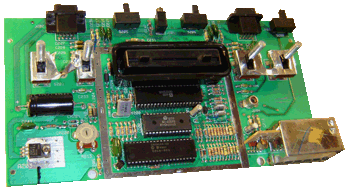
Original Atari 2600 board
The Original board is physically cut down to the most essential parts to fit into the new casing:
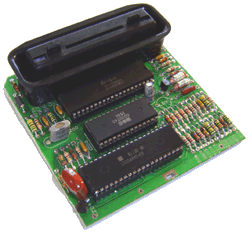
Middle "third" of the original 2600 board
A custom control board was designed replicate functions lost due to the need to cut down the original board. The functions include control to replace the joystick ports and allow for a gameboy like thumbpad.
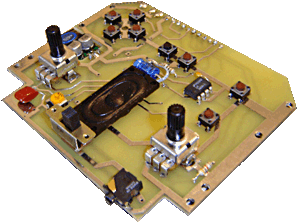
Custom control interface board
Any particular challenges during the design process you’ve had to overcome?
Ben: As stated in the last paragraph, it’s mostly a matter of designing it to look good AND be able to assemble. For example, all the screws inside the unit should be visible at once (ie: screws not covered by other parts) so if you have to take it back apart and troubleshoot it’s easy to get at stuff.
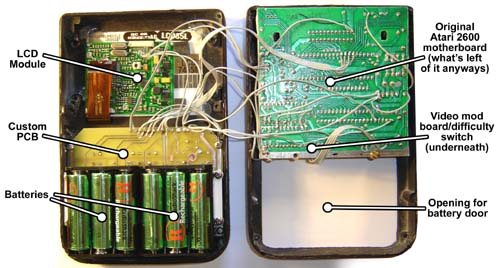
Inside the Phoenix
How long does each take you to build?
Ben: It’s about 3 hours. Not too bad, used to be like 10.
Any thing you would like to change about the design of the Phoenix moving forward?
Ben: It’d be nice if the cartridge could slide down the back, but of course that space is where the [hacked] Atari 2600 board is. I suppose if I used a sort of “Atari on chip” I’d save a lot of room but I’m not sure what the collectors would think of that. Definitely something I’ve thought about, though I’m more of a design guy than a tech expert.
What kind of media attention has your unusual hobby drawn?
Ben: It started as mostly web stuff but as it goes on it’s more magazines / print publications and in 2004 even a few television appearances. I guess the best was being in Popular Science, a magazine even my parents read. Remember, they say you’re not famous until your parents have heard of you!
How did you come up with your various color combinations?
Ben: With the Phoenix? I actually got out some
good old-fashioned paper and art pencils and hammered out the color combos
with a friend of mine who works in an architectural firm. I think a secret
trick of design is putting colors (or shapes also) together that don’t seem like they’d
match but they do.
Some examples:
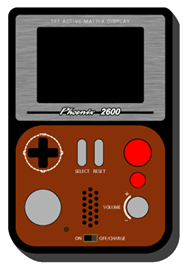
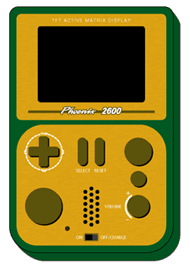
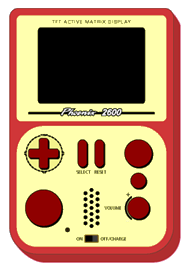
(Left to Right) Classic, Forest Gold, Red Oxide
Are there other portables for sale on your site?
Ben: I’m thinking about doing a SNES version of a Phoenix-like portable. It’d be quite similar in design / size but of course be a SNES. I’m going to cut a prototype case for it this week.
Has your book resulted in greater traffic on your site?
Ben: It seems that way, though in the tech geek world nothing can compare to a Slashdotting (for sheer web hits) My forums have become more popular, which I assume is at least partly driven by my book. Big thing, of course, is how this translates to royalties :)
Have there been any thoughts of making a portable LCD screen Jakks (ex. The Atari plug/play) System?
Ben: Yes, over the years I’ve talked about it with people off and on. The big problem is most of those “joystick games” things are very cheap to make, and thus very profitable. By adding a [decent] screen the manufacturing cost would skyrocket, so it’s probably something a large company, like Jakks, would never do.
What do you think of the PSP? Is there anything you would have liked Sony to have done differently?
Ben: You know I haven’t played one yet... In fact the only time I’ve even seen one was in line for “Revenge of the Sith” (go figure) Aside from that, if there would have been a way to make a portable PS2 compatible it would have sold like GANGBUSTERS. Sure it would have to be a little bigger (a 5” circle bulge for the disc) but man, people would have lined up. The PS2 is old enough, it probably could have been done.
Does Nolen Bushnell have a Phoenix yet?
Ben: Not that I know of. I shook his hand at CGE 2003, but was too afraid to ask if he knew who I was. Really!
Lastly, tell me…..do you have gaming groupies?
Ben: You mean that play classic games? Most of my friends are OK with firing up old systems, usually the NES or the Genesis. Everybody else is into that “World of Warcraft” thing, which I believe won’t run on a 2600 :)
Ben thanks for your time. I know in addition to myself, all of the RetroBlast readers can really appreciate the time and effort that you’ve put into this project.
ABOUT THE AUTHOR
Mitch Gerson, 36 years old, resides in
Manhattan with his wife of 4 years. He discovered the magic of MAME tm
around November of 2002. Two years and two complete arcade cabinets (one
stand up and one cocktail) later he’s still going strong coming up
with various peripherals for his arcade cabs with no end in sight.
